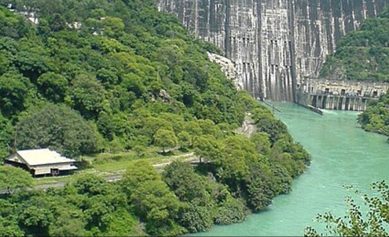Water sharing dispute between Punjab and Haryana: what happened, why
The Bhakra Beas Management Board has ordered the release of an additional 8,500 cusecs of water for Haryana, a decision vehemently opposed by the Punjab government. Here's why.

Amid escalating tensions with Haryana over water sharing, all parties in Punjab came together on Friday to reject the Bhakra Beas Management Boards’s (BBMB’s) decision to release an extra 4,500 cusecs of water to Haryana.
“All parties have unanimously decided to rise above party lines and stand with Punjab,” Chief Minister Bhagwant Mann said in a press conference after the meeting which was attended by AAP, Congress, Akali Dal, BJP, and BSP. The state BJP chief Sunil Jakhar said that “Punjab does not have a single drop to spare”.
The current crisis
The latest stand-off began on April 23, when Haryana sought 8,500 cusecs of water from the Bhakra-Nangal project — 4,500 cusecs more than what it is currently receiving. Punjab CM Mann refused, putting the ball in the court of the BBMP.
In a marathon BBMP meeting chaired by chairman Manoj Tripathi on Wednesday, three of BBMP’s member states — the BJP-ruled Haryana, Rajasthan, and Delhi — voted in favour of releasing extra water to Haryana, effectively bypassing Punjab’s opposition. Congress-ruled Himachal decided not to vote.
Punjab has, however, refused to open additional sluice gates at the Nangal dam which would release this extra water to Haryana. As a result, the Haryana government on Friday said it will move the Supreme Court to secure its fair allocation.
Punjab too is exploring legal options to contest the BBMP’s “unprecedented” decision. “This forcible allocation is unprecedented. We are working on finding a solution. The state government is firm — it will not allow even a drop to go across,” said one Punjab official.
BBMP and water sharing
Conceived as early as the 1910s, the Bhakra-Nangal project is among the earliest post-Independence river valley development projects, one that Prime Minister Jawaharlal Nehru himself took a personal interest in.
It comprises two separate but complementary dams on the River Satluj: the Bhakra dam in Himachal Pradesh, and the Nangal dam, some 10 km downstream, in Punjab.
Before the state was split into Punjab, Haryana, and Himachal Pradesh, the Bhakra-Nangal project was under the direct control of the Punjab government. The Bhakra Management Board was established in 1966, under Section 79 of the Punjab Reorganisation Act, to administer the project in the best interests of all three states.
This board was renamed BBMP in 1976, and given the additional task of managing projects on the River Beas, namely the Beas-Satluj Link Project (Pandoh dam), and Pong dam, both in Himachal.
The BBMP today plays a central role in the distribution of water between Punjab, Haryana, Rajasthan, Himachal Pradesh, and Delhi. At the start of every accounting year (roughly September-August, depending on the monsoon), the BBMP determines how much water would be allocated to each state.
For the current year, it allocated 5.512 million acre-feet (MAF) to Punjab, 2.987 MAF to Haryana, and 3.318 MAF to Rajasthan.
Not enough water
Punjab claims that Haryana has already withdrawn 3.110 MAF — or 104% of its share for the whole year. This is even as the water levels on the Ranjit Sagar (on River Ravi) and Pong dams are 16.9 and 31.87 feet lower than at the same time last year, mainly due to scant snowfall in the Himalayas this winter. The water level at the Bhakra dam too is 12 feet lower than last year.
Haryana Chief Minister Nayab Singh Saini has accused Punjab of playing “dirty politics”, and stated that his state has not even received what it is due.
Haryana said it desperately needs more water for drinking purposes, especially in the water-starved districts of Hisar, Sirsa, and Fatehabad.
In the immediate term, the states have no option but to find common ground, noted water expert A S Dulet told The Indian Express.
“If Haryana’s population needs drinking water, it should be provided, especially since Punjab does not need extra water at this time… The only condition is that each state’s quota must remain unchanged. If extra water is given to Haryana now, Punjab should be compensated later… The fixed share is sacrosanct,” Dulet said.